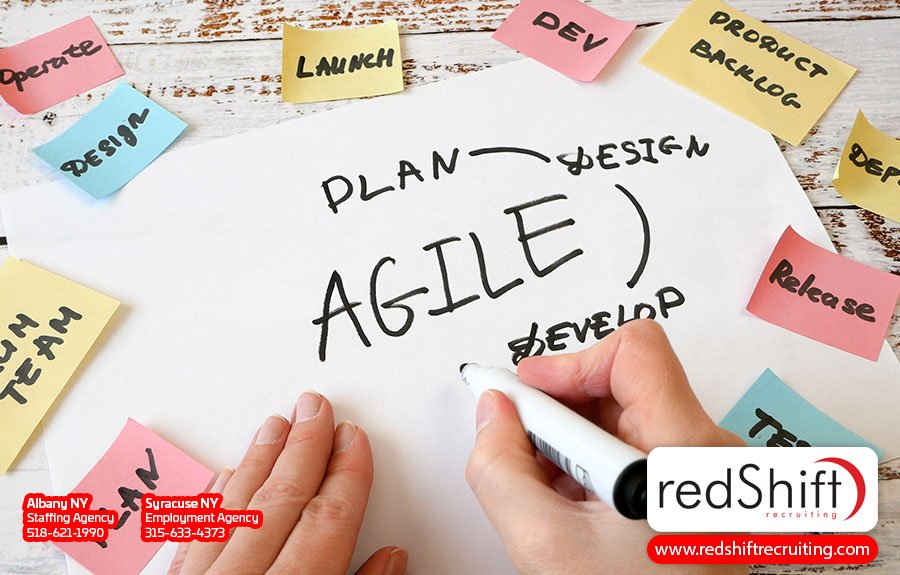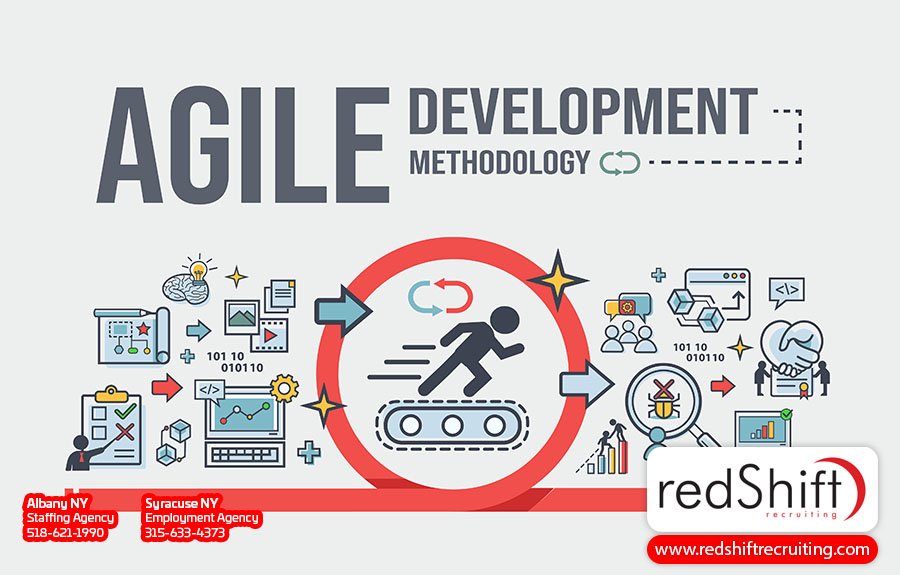
Acing the Outsourcing Game: Outshining Competitors With Agile Methodologies
Are you tired of struggling to keep up with the competition? Is your business losing momentum because you're bogged down by tedious tasks and overwhelming responsibilities? Outsourcing is an effective way to delegate non-core tasks and services to experts while freeing up your team's time and resources, but the success of your outsourcing strategy depends on how effectively you implement it. That's where agile methodologies come in.
Agile methodologies allow you to take a flexible and adaptive approach to outsourcing. By breaking down complex projects into smaller, manageable tasks, you can respond quickly to changes in the market and adapt to new challenges. This allows you to stay ahead of the competition and focus on your core competencies. Agile methodologies are more than just buzzwords—they're a proven approach to achieving success. By implementing agile methodologies in your outsourcing strategy, you can react quickly to changing needs and increase your overall productivity and performance.
In this article, we'll delve into the benefits of agile outsourcing and provide practical tips on how to implement it effectively. Whether you're a small business or a large corporation, incorporating agile methodologies can help you get the most out of your outsourcing efforts and take your business to the next level. Ultimately, that means delivering higher-quality work at a faster pace than your competitors—giving you a crucial edge in the race for growth and profitability.
What Is Outsourcing?
Outsourcing is the practice of delegating a company's tasks, projects, or processes to external service providers, often referred to as outsourcing vendors. This approach has gained popularity in recent years, especially in industries like software development, where agile methodologies have proven to be particularly effective in meeting project goals efficiently and cost-effectively. By partnering with specialized software development companies that use these flexible techniques, businesses can maintain their competitive edge while freeing up internal resources for other essential operations.
What Are Agile Methodologies?
Simply put, agile methodologies are a set of principles and practices that prioritize flexibility, collaboration, and customer satisfaction in the software development process. These techniques have proven to be instrumental in achieving agile outsourcing success by fostering efficient communication between clients and service providers as well as enabling teams to adapt quickly to changing requirements or unforeseen challenges. In essence, agile software development empowers organizations with the necessary tools to outperform their competitors by delivering high-quality products faster while continuously improving throughout the project lifecycle.
The Benefits of Agile Methodologies for Outsourcing
Now that we have a better understanding of what agile methodologies entail, let's delve into how they can give your outsourcing efforts an edge over competitors. Agile methodology provides an effective framework for managing and optimizing the collaboration between you and your outsourcing partner. By adopting agile practices in your outsourcing strategy, you can enjoy increased flexibility, faster delivery times, improved quality control, enhanced communication, and greater customer satisfaction—all vital aspects to staying ahead in today's competitive business environment.
Agile methodologies can help you streamline your outsourcing process by breaking down complex projects into smaller, more manageable tasks. This allows you to respond quickly to changes in the market, adapt to new challenges, and make adjustments to your outsourcing strategy on the fly. By adopting an agile approach, you can also improve communication and collaboration between your team and your outsourcing partners. This helps to ensure that everyone is on the same page and working towards a common goal, leading to a more efficient and productive outsourcing process.
In addition, agile methodologies emphasize continuous improvement, meaning that you can identify and address issues throughout the outsourcing project lifecycle, leading to better outcomes and higher customer satisfaction. Embracing agile outsourcing will not only ensure seamless integration with your service provider but also help both parties adapt quickly to changing market conditions or project requirements while minimizing the risks associated with traditional models of project management. Overall, incorporating agile methodologies into your outsourcing strategy can help you gain a competitive advantage, increase efficiency and productivity, and ultimately achieve your business goals.
What Is an Agile Team?
An agile team is a group of individuals working together to deliver high-quality results using agile methodologies. In the context of outsourcing, an agile team can significantly contribute to outperforming competitors by adapting quickly to changing requirements and continuously improving their processes. By embracing collaboration, communication, and flexibility, these teams are able to rapidly respond to client needs while maintaining efficiency and ensuring timely delivery of desired outcomes. As a result, businesses that successfully integrate agile teams into their outsourcing strategies stand to gain substantial advantages in today's fast-paced marketplace.
Defining Objectives and Outcomes
Defining objectives and outcomes is a crucial aspect of successful outsourcing, providing clear direction for both your in-house team and outsourced partner. Agile methodologies can help by breaking tasks into smaller units, improving delegation, and enabling continuous feedback. This collaborative approach ensures everyone has a comprehensive understanding of project goals and expectations, ultimately leading to better performance and enhanced results.
Developing a Plan for the Project
Developing a comprehensive plan is essential to the success of any outsourcing project, and this is especially true when implementing agile methodologies. During the project planning phase, it's essential to carefully consider and outline each aspect of the process, from timelines to resource allocation. Start by identifying your business objectives and determining how outsourcing can help you achieve them. From there, you can determine which tasks to outsource and which to keep in-house, in addition to defining clear roles and responsibilities for both your team and your outsourcing partner. Setting realistic timelines and milestones, as well as establishing communication channels and feedback mechanisms, are also crucial components of a successful outsourcing plan.
By taking the time to develop a detailed plan, you can ensure that your outsourcing project is aligned with your business goals and that you are set up for success from the outset. This ultimately leads to more efficient processes, higher-quality results, and an increased likelihood of outshining competitors.
Communicating and Collaborating With Stakeholders
Effective communication and collaboration are indispensable for effective project management. When outsourcing, it's critical to establish clear lines of communication and define the expectations and responsibilities of each stakeholder involved. Providing communication channels that allow stakeholders to actively participate in discussions will not only ensure everyone is on the same page, but will also allow for transparency and accountability throughout the project lifecycle. By fostering a collaborative environment that values open communication and feedback, stakeholders can anticipate project changes and adapt quickly to them. By fostering an environment where information flows freely and feedback loops are continuous, you'll find it easier to meet goals and keep everyone on the same page. This approach will help your outsourcing team stay aligned with your business objectives and achieve them efficiently, ultimately leading to better results and greater customer satisfaction.
Monitoring Progress and Adapting Strategies
Once the project is underway, you’ll need to constantly monitor progress and adapt your strategies as needed. By leveraging agile methodologies, you can set up regular checkpoints to monitor the project and assess whether it is on track to meet its goals. Keep an open line of communication with your outsourcing partner to identify potential issues and take corrective action before they become major problems. By adapting your strategies based on feedback and changing project needs, you can improve your outsourcing team's performance and ensure the project's success.
Continuously monitoring progress and adapting strategies is a vital part of agile software development that allows businesses to stay agile and competitive in an ever-changing market. By keeping a close eye on project milestones, communication channels, and team performance metrics, you'll be well-equipped to identify areas that require improvement or adaptation. This will enable you to refine your approach for future projects in addition to ensuring maximum efficiency in real-time.
Avoiding Common Pitfalls
In order to fully reap the benefits of agile methodologies, it's important for organizations to stay aware of potential obstacles that can hinder their success, such as poor communication, a lack of transparency, inadequate planning or training, and inflexible contracts. Failure to establish clear communication channels and roles at the beginning of a project can lead to confusion and delays. Underestimating the time and resources needed to implement agile methodologies effectively can also hinder progress. Additionally, it's important to monitor progress and adapt strategies in response to changing needs.
To overcome these hurdles, companies should foster open dialogue with their outsourcing partners, set clear expectations, invest in ongoing education for team members, and establish mutually beneficial agreements that allow for necessary adjustments. By identifying these challenges early on and implementing proactive measures, businesses will be better equipped to navigate the complex developer outsourcing landscape successfully.
Utilizing Tools and Technologies
Staying ahead of the competition requires leveraging the latest tools and technologies. When it comes to outsourcing, the use of cutting-edge tools and technologies can greatly enhance collaboration, streamline processes, improve overall efficiency, and ultimately deliver higher-quality products in a shorter amount of time.
For instance, project management software can help track progress, assign tasks, and facilitate communication between team members and outsourcing partners. Additionally, cloud-based platforms enable real-time access to project data and resources, allowing for seamless collaboration from anywhere in the world. By utilizing these tools and technologies, companies can improve their outsourcing efforts and achieve optimal results while minimizing risk and maximizing ROI.
Continuous Improvement
Continuous improvement is a core principle of agile methodologies and is crucial to ensuring the success of outsourcing efforts. By continuously evaluating and adapting processes, teams can identify areas for improvement and implement changes that lead to better outcomes. Refining processes and incorporating feedback from team members and clients will enable them to optimize their performance and adapt quickly to changes while maintaining a competitive edge.
This involves setting benchmarks, analyzing performance metrics, and soliciting feedback from all stakeholders involved in the outsourcing process. With this information, teams can make data-driven decisions that lead to increased efficiency, improved quality, and enhanced customer satisfaction. Embracing a culture of continuous improvement not only benefits the current project but also fosters a culture of agility and growth, which will drive long-term sustainability and lay the foundation for future success.
Measuring Results
Effectively measuring results is another critical step in implementing a successful agile outsourcing strategy. By consistently tracking progress and analyzing data, businesses can evaluate the success of the project and identify areas for improvement.
Regularly assessing key performance indicators (KPIs) such as project delivery times, client satisfaction levels, quality of deliverables, and return on investment will provide valuable insights into how well a company is managing its outsourced projects. Through continuous monitoring and analysis of these metrics, companies can make data-driven decisions and optimize their outsourcing strategies. Regular reporting and feedback loops are also essential to keeping stakeholders informed and engaged throughout the project lifecycle.
Ultimately, this continuous feedback loop allows organizations to refine their strategies and forge stronger partnerships with outsourcing providers while providing valuable insights for future projects.
The Future of Agile Outsourcing
The future of agile outsourcing is looking bright as more and more companies recognize the benefits of implementing agile methodologies in their outsourcing efforts. With advancements in technology and communication, it's becoming easier to collaborate with outsourcing partners from all over the world in real-time. Additionally, with the growing popularity of remote work, outsourcing teams are becoming more diverse and inclusive, bringing unique perspectives and skill sets to the table. As agile methodologies continue to evolve, we can expect to see even greater levels of efficiency, innovation, and collaboration in the outsourcing industry, leading to better products and services for businesses and consumers alike.
Frequently Asked Questions
How Do I Choose the Right Outsourcing Partner for Implementing Agile Methodologies?
Choosing the right outsourcing partner for implementing agile methodologies is crucial to the success of your project. When selecting a partner, it's essential to look beyond just their technical skills and evaluate their experience in agile software development, their communication skills, and their ability to collaborate effectively with your in-house team. Consider the partner's track record of delivering high-quality products on time, their cultural fit with your organization, and their willingness to embrace and adapt to your business goals and objectives. Look for a partner who is transparent in their approach, has a strong project management framework in place, and is responsive to feedback and requests for change. Additionally, consider their level of expertise in the specific domain of your project and the extent to which they can contribute value beyond just technical execution. Don't forget about cost and scalability either; make sure your chosen partner is able to meet your budget constraints while also being capable of handling any changes in project scope or team size down the line. By carefully evaluating potential outsourcing partners based on these criteria, you can make an informed decision and ensure a successful partnership for implementing agile methodologies.
What Are the Key Challenges Faced by Organizations in Transitioning From Traditional to Agile Outsourcing?
One of the key challenges organizations face when transitioning from traditional to agile outsourcing is adapting their management and communication styles. This requires a shift in organizational culture and mindset from a rigid, linear approach to a more collaborative approach with an emphasis on flexibility, transparency, and continuous improvement. Organizations may struggle to make this change if they encounter resistance from employees or managers who are accustomed to traditional project management methods.
Another challenge is finding the right outsourcing partner who understands and can implement agile methodologies effectively. In addition, organizations must ensure that their in-house team is equipped with the necessary skills and knowledge to collaborate effectively with the outsourced team.
Communication and coordination between the in-house and outsourced teams can also be challenges, as can adapting to the fast-paced, iterative nature of agile development. Finally, organizations may face resistance from stakeholders who are used to the traditional outsourcing model and may be hesitant to adopt a new approach.
To overcome these obstacles, it's crucial for organizations to invest in proper training and support systems that help foster a culture that embraces change and innovation.
How Can We Align Company Culture and Work Ethics Between the Client and the Outsourcing Partner in an Agile Environment?
To ensure the alignment of company culture and work ethics between the client and the outsourcing partner in an agile environment, it's essential to establish open communication channels, foster collaboration, and develop a shared understanding of goals and expectations.
This can be achieved by involving both parties in project planning sessions, encouraging regular feedback through stand-ups or retrospectives, and providing opportunities for team bonding activities that promote cultural exchange. By embracing transparency and actively working together to address potential challenges, clients and their outsourcing partners can successfully create a cohesive and productive agile partnership.
What Are the Best Practices for Training and Upskilling Outsourced Teams in Agile Methodologies?
In order to effectively train and upskill outsourced teams in agile methodologies, it's essential to follow a few best practices. First, provide comprehensive training materials and training sessions that are tailored to the specific needs of your project and team members, including online resources, workshops, webinars, and hands-on exercises. Encourage open communication between all parties involved, as this will foster a collaborative environment conducive to learning.
Additionally, provide ongoing coaching and mentorship from experienced agile practitioners who can guide the team through challenges and ensure they're continuously improving their skills. Finally, track progress using key performance indicators (KPIs) to measure success and identify areas for further development or support. By following these strategies, you'll set your outsourced team up for success with agile methodologies and ultimately enhance the overall effectiveness of your collaboration.
How Do We Maintain Balance Between Strong Governance and Flexibility in an Agile Outsourcing Model?
To maintain the balance between strong governance and flexibility in an agile outsourcing model, it's essential to establish clear roles, responsibilities, and communication channels among all stakeholders. Ensuring that both the client and the service provider have a shared understanding of project goals, timelines, and expected outcomes is crucial for effective collaboration.
Additionally, having a robust yet adaptable governance framework can help provide structure while allowing room for adjustments based on evolving requirements or new insights. This should include regular reviews of progress, transparent reporting mechanisms, and timely feedback loops to enable continuous improvement and adaptation as needed. By striking the right balance between control and adaptability, organizations can reap the benefits of agility without compromising on accountability and efficiency.
Conclusion
In conclusion, adopting agile methodologies for outsourcing can provide businesses with a competitive advantage, allowing them to outshine their competitors. By embracing agility in the outsourcing process, organizations can effectively respond to changing market demands, accelerate project delivery, and foster a culture of collaboration and innovation. Agile methodologies promote transparency, adaptability, and iterative development, enabling teams to quickly adapt to evolving requirements and deliver high-quality solutions. This approach also enhances communication, alignment, and trust between stakeholders, both internally and with outsourcing partners. By acing the outsourcing game with agile methodologies, businesses can stay ahead in a rapidly changing business landscape and achieve superior results in their software development endeavors.



